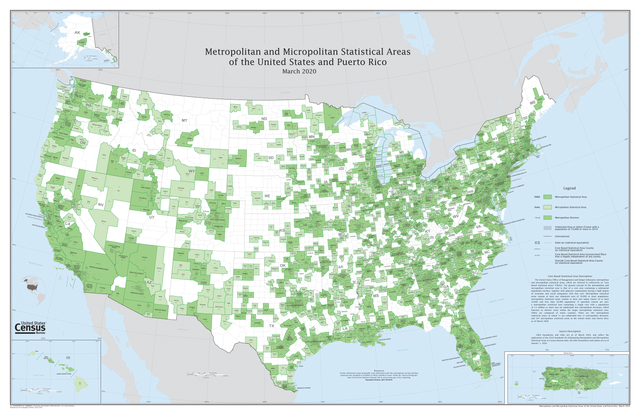Micropolitan_statistical_area
Micropolitan statistical area
Statistical area of the United States
United States micropolitan statistical areas (μSA, where the initial Greek letter mu represents "micro-"), as defined by the Office of Management and Budget (OMB), are labor market and statistical areas in the United States centered on an urban cluster (urban area) with a population of at least 10,000 but fewer than 50,000 people.[1] The micropolitan area designation was created in 2003. Like the better-known metropolitan statistical areas, a micropolitan area is a geographic entity used for statistical purposes based on counties and county equivalents.[1] On July 21, 2023, the Office of Management and Budget released revised delineations of the various CBSAs in the United States, which recognized 542 micropolitan areas in the United States, four of which are in Puerto Rico.[2]
The term "micropolitan" gained currency in the 1990s to describe growing population centers in the United States that are removed from larger cities, in some cases by 100 miles (160 km) or more.
Micropolitan cities do not have the economic or political importance of large cities, but are nevertheless significant centers of population and production, drawing workers and shoppers from a wide local area. Because the designation is based on the core urban cluster's population and not on that of the whole area, some micropolitan areas are much larger than other metropolitan areas. For example, the Ottawa, IL Micropolitan Statistical Area had a 2010 census population of 154,908. That would put its total population ahead of roughly 100 individual locations classified as a metropolitan statistical area in 2010. The largest of the areas, around Claremont and Lebanon, New Hampshire, had a population in excess of 218,000 in 2010; Claremont's population was only 13,355 in that year's census,[3] and Lebanon's population was only 13,151.[4]

The following sortable table lists the 538 μSAs of the incorporated United States (the 50 states and the District of Columbia) with the following information:
- The μSA rank by population as of July 1, 2023, as estimated by the United States Census Bureau[5]
- The μSA name as designated by the United States Office of Management and Budget[6]
- The μSA population as of July 1, 2023, as estimated by the United States Census Bureau[5]
- The μSA population as of April 1, 2020, as enumerated by the 2020 United States census[5][lower-alpha 1]
- The percent μSA population change from April 1, 2020, to July 1, 2023[5]
- The combined statistical area (CSA)[7] if it is designated and the μSA is a component[6]
The following sortable table lists the 4 μSAs (USAs) of Puerto Rico with the following information:
- The μSA rank by population as of July 1, 2023, as estimated by the United States Census Bureau[5]
- The μSA name as designated by the United States Office of Management and Budget[6]
- The μSA population as of July 1, 2023, as estimated by the United States Census Bureau[5]
- The μSA population as of April 1, 2020, as enumerated by the 2020 United States census[5][lower-alpha 1]
- The percent USA population change from April 1, 2020, to July 1, 2023[5]
- The combined statistical area (CSA)[7] if the MSA is a component[6]
| Rank | Micropolitan statistical area | 2023 estimate | 2020 census | Change | Encompassing combined statistical area |
|---|---|---|---|---|---|
| 1 | Coamo, PR μSA | 53,355 | 54,949 | −2.90% | Ponce–Coamo, PR Combined Statistical Area |
| 2 | Lares, PR μSA | 27,729 | 28,105 | −1.34% | San Juan–Bayamón, PR Combined Statistical Area |
| 3 | Utuado, PR μSA | 27,242 | 28,287 | −3.69% | San Juan–Bayamón, PR Combined Statistical Area |
| 4 | Coco, PR μSA | 24,718 | 25,789 | −4.15% | San Juan–Bayamón, PR Combined Statistical Area |
- Executive Office of the President (July 21, 2023). "Revised Delineations of Metropolitan Statistical Areas, Micropolitan Statistical Areas, and Combined Statistical Areas, and Guidance on Uses of the Delineations of These Areas" (PDF) (Press release). Retrieved July 21, 2023.
- "Geographic Identifiers: 2010 Census Summary File 1 (G001): Claremont city, New Hampshire". U.S. Census Bureau, American Factfinder. Archived from the original on February 13, 2020. Retrieved August 30, 2017.
- "Geographic Identifiers: 2010 Demographic Profile Data (G001): Lebanon city, New Hampshire". U.S. Census Bureau, American Factfinder. Archived from the original on February 13, 2020. Retrieved August 30, 2017.
- "Metropolitan and Micropolitan Statistical Areas Population Totals: 2020-2023". United States Census Bureau, Population Division. March 14, 2024. Retrieved March 16, 2024.
- The United States Office of Management and Budget (OMB) defines a CSA (CSA) as an aggregate of adjacent core-based statistical areas that are linked by commuting ties.
 Definitions from Wiktionary
Definitions from Wiktionary Media from Commons
Media from Commons News from Wikinews
News from Wikinews Quotations from Wikiquote
Quotations from Wikiquote Texts from Wikisource
Texts from Wikisource Textbooks from Wikibooks
Textbooks from Wikibooks Resources from Wikiversity
Resources from Wikiversity
- 2010 United States census
- USCB population estimates
- United States Office of Management and Budget
- Nasser, Haya El (June 27, 2004). "Small-town USA goes 'micropolitan'". USA Today. Retrieved 2008-07-23.
- Nasser, Haya El (November 22, 2004). "For political trends, think micropolitan". USA Today. Retrieved 2008-07-23.
- McCarthy, Michael J. (August 23, 2004). "Main Street America Gets a New Moniker". Real Estate Journal/Wall Street Journal. Archived from the original on February 14, 2005. Retrieved 2008-07-23.